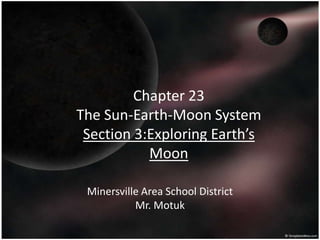Chapter 23 section 3 notes (exploring earth's moon)
•Descargar como PPTX, PDF•
0 recomendaciones•2,880 vistas
The document summarizes missions that have explored Earth's moon, including early Soviet and American spacecraft in the 1950s-60s, the Apollo 11 mission that landed astronauts in 1969, and more recent unmanned missions like Clementine in 1994 and Lunar Prospector in 1998. Clementine mapped the moon's surface and composition, identifying the largest impact basin. Lunar Prospector found evidence that supported the impact theory of the moon's origin and discovered ice in deep polar craters.
Denunciar
Compartir
Denunciar
Compartir

Más contenido relacionado
La actualidad más candente
La actualidad más candente (20)
Environmental Science (EVS) : Earth and its neighbours (Class II) 

Environmental Science (EVS) : Earth and its neighbours (Class II)
The Earth in the Solar System class 6th geography ppt 

The Earth in the Solar System class 6th geography ppt
Similar a Chapter 23 section 3 notes (exploring earth's moon)
Potential Habitable Exoplanets: Interstellar Space Travel As Mankind's Salvation

Potential Habitable Exoplanets: Interstellar Space Travel As Mankind's SalvationAhmad Afandi Nor Azmi
Similar a Chapter 23 section 3 notes (exploring earth's moon) (20)
Potential Habitable Exoplanets: Interstellar Space Travel As Mankind's Salvation

Potential Habitable Exoplanets: Interstellar Space Travel As Mankind's Salvation
Photogeology of the moon 1 photogeology of the moon lab

Photogeology of the moon 1 photogeology of the moon lab
Más de Mr. Motuk
Más de Mr. Motuk (20)
Do not copy (Chapter 5 Section 1: Supplemental Notes)

Do not copy (Chapter 5 Section 1: Supplemental Notes)
Chapter 3 section 2 notes (moving cellular material)

Chapter 3 section 2 notes (moving cellular material)
Chapter 23 section 3 notes (exploring earth's moon)
- 1. Chapter 23The Sun-Earth-Moon SystemSection 3:Exploring Earth’s Moon Minersville Area School District Mr. Motuk
- 2. Section 3: Exploring Earth’s Moon Missions to the Moon. Early Exploration The First Luna Spacecraft, launched by the Soviet Union in 1959, enabled close study of the Moon. The Ranger spacecraft and the Lunar Orbiters of the United States took detailed photographs of the Moon in the 1960’s. Five Surveyor United States Spacecraft landed on the Moon. Astronauts of the Apollo 11 landed on the moon in 1969.
- 3. Section 3: Exploring Earth’s Moon Missions to the Moon. Early Exploration No manned missions to the moon since the Apollo missions. The Clementine spacecraft was placed in lunar orbit in 1994 to survey the moon’s surface. Collected data on the mineral content of the Moon rocks. Mapped features of the Moon’s surface. Impact basins, or craters, are depressions left by objects striking the moon.
- 4. Section 3: Exploring Earth’s Moon Missions to the Moon. The Clementine spacecraft was placed in lunar orbit in 1994 to survey the moon’s surface. Identified South Pole-Aitken Basin, the largest and deepest impact crater in the solar system.
- 5. Section 3: Exploring Earth’s Moon Mapping the Moon Data from Clementine yielded a map of the Moon showing its composition. The Moon’s crust is thinnest under its impact basin. The crust on the side of the moon facing Earth is thinner than on the far side of the Moon. The Lunar Prospector was launched in 1998 to look for clues about the Moon’s origin and makeup. Small, iron-rich core of the Moon supports the impact theory of the Moon’s origin. Findings confirmed that ice was present in deep craters at the poles.